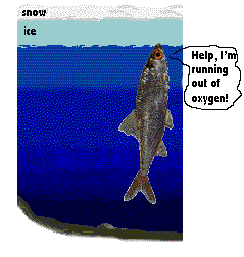Organisms use oxygen also in the winter although their vital functions (e.g. breathing) are weak, and there are a lot less organisms than there are in the summer. The oxygen production of water plants and phytoplankton is nearly non-existent.
Micro-organisms in lakes break down organic matter even in the winter; it consumes oxygen. Especially in eutrophic and humous lakes, microbe activity consumes a lot of oxygen. Also bigger organisms (larvae, fish, etc.) need oxygen even though their functions are slow in cold water. At the bottom of lakes, where the temperature is slightly higher than immediately under the ice, there is more microbe activity than elsewhere in the water.
In barren lakes and running waters, the oxygen usually lasts through the whole winter. In unfrozen rapids, some oxygen blends into the water from the air.
Plants produce oxygen by photosynthesis. In the winter, the majority of water plants are in dormancy or totally withered, so they do not photosynthesise. There are also very few green planktonalgae in water in the winter.
